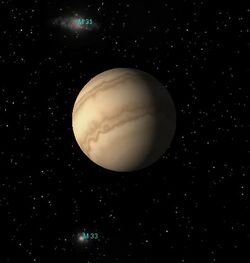Astronomy:HD 69830 b
From HandWiki
Short description: Neptunian-sized exoplanet orbiting HD 69830
 | |
| Discovery | |
|---|---|
| Discovered by | C. Lovis et al.[1] |
| Discovery date | May 18, 2006 |
| Radial velocity | |
| Orbital characteristics | |
| 0.0764 ± 0.0017 AU (11,430,000 ± 250,000 km)[2] | |
| Eccentricity | 0.128±0.028[2] |
| Orbital period | 8.66897±0.00028 d[2] |
| astron|astron|helion}} | 2,453,496.8 ± 0.06 |
| 340 ± 26 | |
| Semi-amplitude | 3.4±0.1 m/s[2] |
| Star | HD 69830 |
| Physical characteristics | |
| Mass | ≥10.1+0.38 −0.37 M🜨[2] |
| Physics | ~804 K |
HD 69830 b is a Neptune-mass or super-Earth-mass exoplanet orbiting the star HD 69830. It is at least 10 times more massive than Earth. It also orbits very close to its parent star and takes 82/3 days to complete an orbit.
Based on theoretical modeling in the 2006 discovery paper, this is likely to be a rocky planet, not a gas giant.[1] However, other work has found that if it had formed as a gas giant, it would have stayed that way,[3] and it is now understood that planets this massive are rarely rocky.[4]
If HD 69830 b is a terrestrial planet, models predict that tidal heating would produce a heat flux at the surface of about 55 W/m2. This is 20 times that of Io.[5]
References
- ↑ 1.0 1.1 Lovis, Christophe et al. (2006). "An extrasolar planetary system with three Neptune-mass planets". Nature 441 (7091): 305–309. doi:10.1038/nature04828. PMID 16710412. Bibcode: 2006Natur.441..305L. http://obswww.unige.ch/~pernier/publications-www/articles-pdf-ps/2006Natur.441..305L.pdf. Retrieved 2013-11-22.
- ↑ 2.0 2.1 2.2 2.3 2.4 Laliotis, Katherine et al. (February 2023). "Doppler Constraints on Planetary Companions to Nearby Sun-like Stars: An Archival Radial Velocity Survey of Southern Targets for Proposed NASA Direct Imaging Missions". The Astronomical Journal 165 (4): 176. doi:10.3847/1538-3881/acc067. Bibcode: 2023AJ....165..176L.
- ↑ H. Lammer (2007). "The impact of nonthermal loss processes on planet masses from Neptunes to Jupiters". Geophysical Research Abstracts 9 (7850). http://www.cosis.net/abstracts/EGU2007/07850/EGU2007-J-07850.pdf?PHPSESSID=1eb3a7a98603083dda25d18001ea2a33.
- ↑ Chen, Jingjing; Kipping, David (2017). "Probabilistic Forecasting of the Masses and Radii of Other Worlds". The Astrophysical Journal 834 (1): 17. doi:10.3847/1538-4357/834/1/17. Bibcode: 2017ApJ...834...17C.
- ↑ Jackson, Brian; Richard Greenberg; Rory Barnes (2008). "Tidal Heating of Extra-Solar Planets". Astrophysical Journal 681 (2): 1631. doi:10.1086/587641. Bibcode: 2008ApJ...681.1631J.
Coordinates: ![]() 08h 18m 23.9s, −12° 37′ 55.8″
08h 18m 23.9s, −12° 37′ 55.8″
 |
